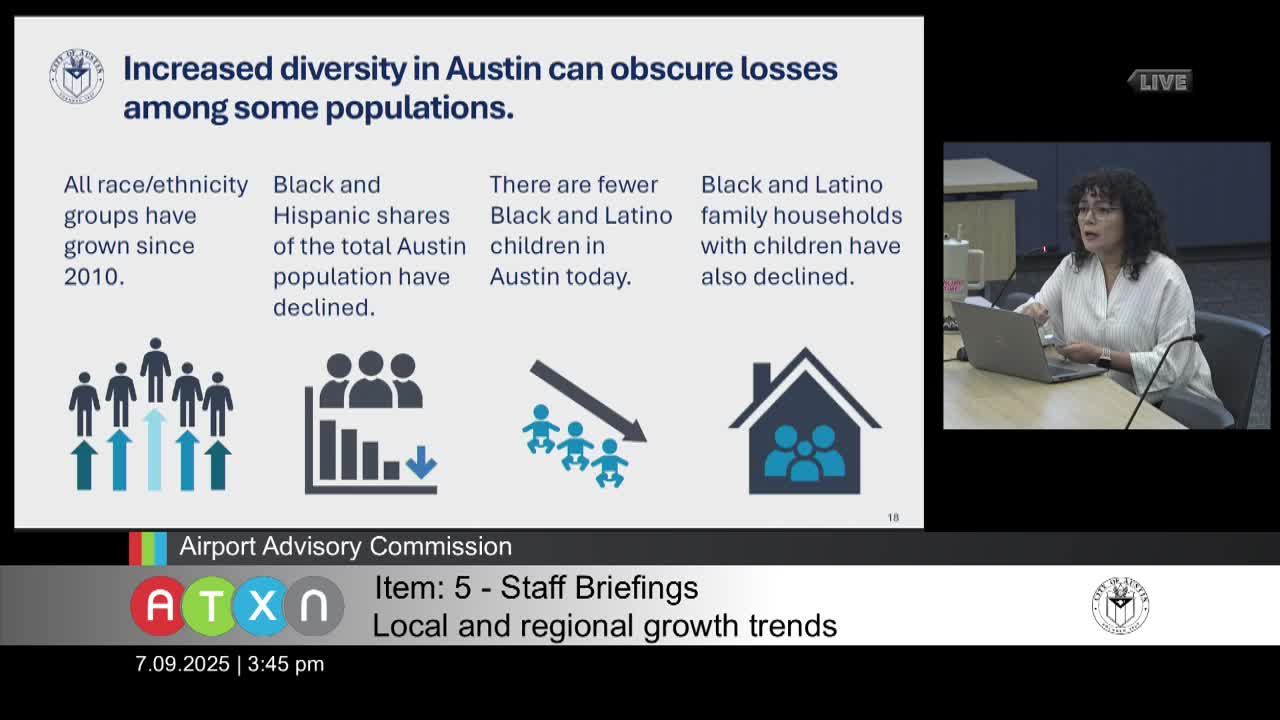Austin reports rapid growth in Asian households as Hispanic and Black populations lag
July 09, 2025 | Austin, Travis County, Texas
This article was created by AI summarizing key points discussed. AI makes mistakes, so for full details and context, please refer to the video of the full meeting. Please report any errors so we can fix them. Report an error »

Austin's demographic landscape is shifting, with significant growth in the Asian population, according to recent discussions at the Airport Advisory Commission meeting. The Asian community is not only expanding rapidly but is also establishing deep roots in the city, marking a notable change in Austin's cultural fabric.
Data presented during the meeting highlighted that Asian households, particularly those with children, are among the fastest-growing family types in Austin. This trend reflects a broader national and state pattern, indicating a vibrant and diverse community that is increasingly integral to the city's identity.
In contrast, the Hispanic population in Austin is experiencing slower growth, increasing by about 20%—a stark difference compared to the 50% growth seen across Texas and the U.S. This marks a significant moment, as it is the first time the share of the Hispanic population has declined, despite its growth in absolute numbers.
The Black population in Austin is also growing, albeit marginally, with the city capturing less than 1% of the overall increase in the Black population across Texas. This slow growth occurs even as many African Americans migrate back to southern cities, highlighting a complex demographic shift within Austin.
Current statistics reveal that non-Hispanic whites make up approximately 47% of the population, while Hispanics account for about 32.5%. The Asian population stands at nearly 9%, and the Black population is just under 7%. Additionally, there is a notable multiracial population nearing 4%.
These findings underscore the importance of recognizing the nuanced changes within Austin's demographics, as the city becomes increasingly diverse while also facing challenges related to the growth rates of its Hispanic and Black communities.
Data presented during the meeting highlighted that Asian households, particularly those with children, are among the fastest-growing family types in Austin. This trend reflects a broader national and state pattern, indicating a vibrant and diverse community that is increasingly integral to the city's identity.
In contrast, the Hispanic population in Austin is experiencing slower growth, increasing by about 20%—a stark difference compared to the 50% growth seen across Texas and the U.S. This marks a significant moment, as it is the first time the share of the Hispanic population has declined, despite its growth in absolute numbers.
The Black population in Austin is also growing, albeit marginally, with the city capturing less than 1% of the overall increase in the Black population across Texas. This slow growth occurs even as many African Americans migrate back to southern cities, highlighting a complex demographic shift within Austin.
Current statistics reveal that non-Hispanic whites make up approximately 47% of the population, while Hispanics account for about 32.5%. The Asian population stands at nearly 9%, and the Black population is just under 7%. Additionally, there is a notable multiracial population nearing 4%.
These findings underscore the importance of recognizing the nuanced changes within Austin's demographics, as the city becomes increasingly diverse while also facing challenges related to the growth rates of its Hispanic and Black communities.
View full meeting
This article is based on a recent meeting—watch the full video and explore the complete transcript for deeper insights into the discussion.
View full meeting
